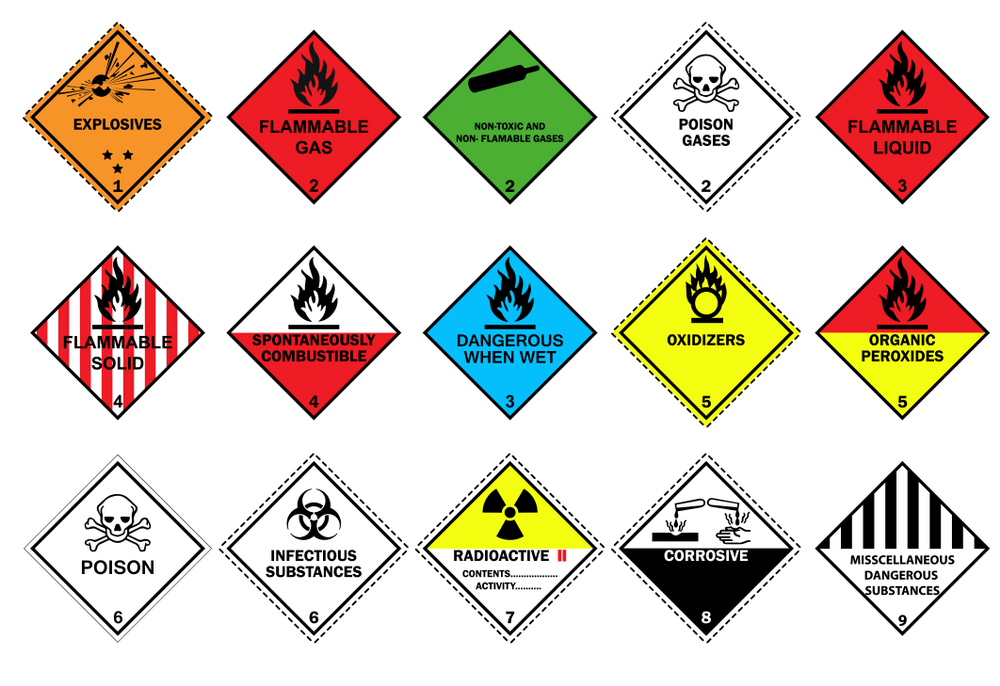TYPES OF DANGEROUS GOODS
Transportation of dangerous goods is carried out by the following types of transport:
By road, sea, air, and rail. For a particular type of transport, certain rules and regulations are created in the organization of transportation, namely, documentation, marking, requirements for the composition of the accompanying cargo. This transportation requires from the operating personnel confident knowledge of any cargo transportation, compliance with the rules of behavior in an emergency to the corresponding hazard class. Personnel must be properly trained and classified.
WHAT HAZARD CLASSES ARE ADR CARGOES
Any dangerous cargo allowed for transportation has its own hazard class. There are nine such classes in total. Each class has a subclass for a particular hazardous substance.
We will consider in more detail about each hazard class below:
DANGEROUS GOODS CLASS 1 (ADR – 1)
Materials that can explode, start a fire, and also cause an explosion, as well as substances containing pyrotechnic effects. Substances that pose a projection hazard and do not lead to explosions. Products which, when ignited, give off radiant heat or minor explosive effects. Items of low sensitivity that present a mass explosion hazard but have very little danger of going from combustion to detonation.
DANGEROUS GOODS CLASS 2 (ADR – 2)
The second class of hazard mainly includes gases (for example, oxygen). Especially as mixtures of gases, pure gas, mixtures of several types of gases. Gas is a substance that, at a temperature of fifty degrees Celsius, has a vapor pressure of more than three hundred kPa. It should be remembered that the main danger of gases is the pressure under which it is located. Gases can be asphyxiant, poisonous, toxic, corrosive, flammable.
Gases that are non-flammable also include non-toxic gases;
Gases are flammable, again poisonous;
Chemically unstable gases, and poisonous gases.
DANGEROUS GOODS CLASS 3 (ADR – 3)
The third class includes flammable substances, liquid and solid in a molten state with a flash point of no more than sixty-one degrees Celsius, as well as explosives that are dissolved in water or other liquid substances to create a homogeneous mixture of a liquid state in order to minimize the possibility of their explosion. This class of cargo includes diesel fuel, light heating oil, gas oil, and also paint (we described the process of transporting paint).
DANGEROUS GOODS CLASS 4 (ADR – 4)
These are substances that are easily flammable as a result of fire, friction, absorption of moisture, and when heated. Also explosives, which are solids. Self-reactive liquid or solid. Solids include granular, powdery, pasty, which can easily ignite when exposed to external factors (sunlight, a lit match, spark). Products capable of spontaneous combustion. They are pyrophoric substances that include mixtures and liquid solutions. These substances are most capable of spontaneous combustion. It occurs when the rate of heat generation exceeds the rate of heat transfer and the autoignition temperature is reached. Products that emit flammable gases when in contact with water.
DANGEROUS GOODS CLASS 5 (ADR – 5)
Oxidizing products, which easily release oxygen, support combustion, and can explode and ignite when interacting with other substances. This class also includes organic substances that consist of derivatives of hydrogen peroxide products. They are called organic peroxides for short.
DANGEROUS GOODS CLASS 6 (ADR – 6)
The sixth grade included products of a poisonous plan, which contribute to poisoning, illness if ingested, contact with skin or mucous membranes. Sometimes they can cause death. These are highly toxic, toxic and slightly toxic substances. Infectious substances that contain pathogenic organisms.
DANGEROUS GOODS CLASS 7 (ADR – 7)
The seventh grade includes radioactive materials. These are products containing radionuclides. The danger of this cargo is that it is possible to receive radioactive radiation in the form of alpha-beta, as well as gamma radiation. These substances can spontaneously ignite, be corrosive, and release thermal energy. Burns, hair loss, changes in blood composition, cancer, leukemia, death are possible in contact.
DANGEROUS GOODS CLASS 8 (ADR – 8)
Corrosive substances are substances that act on the epithelial tissue of the mucous membrane or skin upon contact. Can cause damage to cargo, vehicles, and other types of danger. As a rule, these are acids, alkalis, and highly corrosive products.
DANGEROUS GOODS CLASS 9 (ADR – 9)
These are all other and dangerous substances that were not included in the list of previous classes. This is either fine dust, which is harmful to health when inhaled, and when burning, it can release dioxins, as well as flammable vapors.

CLASSIFICATION OF DANGEROUS GOODS
Class 1: Explosive substances
Class 2.1: Flammable gases
Class 2.2: Non-flammable / non-toxic Gases
Class 2.3: Toxic gases
Class 3: Flammable liquids
Class 4.1: Flammable solids
Class 4.2: Spontaneously flammable substances
Class 4.3: Substances hazardous when wet
Class 5.1: Oxidizing substances
Class 5.2: Organic peroxides
Class 6: Toxic substances
Class 7: Radioactive substances
Class 8: Corrosive substances





